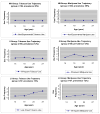Comorbid trajectories of tobacco and marijuana use as related to psychological outcomes
- PMID: 22489588
- PMCID: PMC3325512
- DOI: 10.1080/08897077.2011.640202
Comorbid trajectories of tobacco and marijuana use as related to psychological outcomes
Abstract
Heterogeneous classes of comorbid trajectories of tobacco and marijuana use were examined in order to determine how they are related to subsequent antisocial behavior, poor self-control, and internalizing behavior. Data are from a 4-wave longitudinal study of African American (n = 243) and Puerto Rican (n = 232) adolescents and adults in the community. Logistic regression analyses were employed to measure the association between the comorbid trajectories of tobacco and marijuana use and the psychological difficulty variables. The authors found 6 joint trajectory groups. The authors compared the non-or-experimental tobacco/marijuana use group with the other user groups in each of the psychological difficulty domains. The infrequent tobacco/late-onset marijuana use and chronic tobacco/marijuana use groups differed most strongly from the non-or-experimental tobacco/marijuana use group across the antisocial behavior, poor self-control, and internalizing problems domains. The chronic tobacco/maturing out marijuana use group also had significant associations in each of these domains. The infrequent tobacco/marijuana use and late-onset tobacco/infrequent marijuana use groups had no or weak associations with the psychological outcomes. Tobacco and marijuana cessation programs should identify and address comorbid use of tobacco and marijuana, and antisocial behavior, poor self-control, and internalizing problems, which are associated with histories of comorbid use of the 2 substances.
Figures
References
-
- Richter KP, Kaur H, Resnicow K, Nazir N, Mosier MC, Ahluwalia JS. Cigarette smoking among marijuana users in the United States. Subst Abus. 2004;25:35–43. - PubMed
-
- Lai S, Lai H, Page JB, McCoy CB. The association between cigarette smoking and drug abuse in the United States. J Addict Dis. 2000;19:11–24. - PubMed
-
- Substance Abuse and Mental Health Services Administration. Results from the 2007 National Survey on Drug Use and Health: Detailed Tables. Rockville, MD: Office of Applied Studies; 2008.
-
- Hall W, Degenhardt L. Adverse health effects of non-medical cannabis use. Lancet. 2009;374:1383–1391. - PubMed
-
- Vianna EO, Gutierrez MRP, Barbieri MA, Caldeira RD, Bettiol H, Da Silva AAM. Respiratory effects of tobacco smoking among young adults. Am J Med Sci. 2008;336:44–49. - PubMed
Publication types
MeSH terms
Grants and funding
LinkOut - more resources
Full Text Sources
Medical


